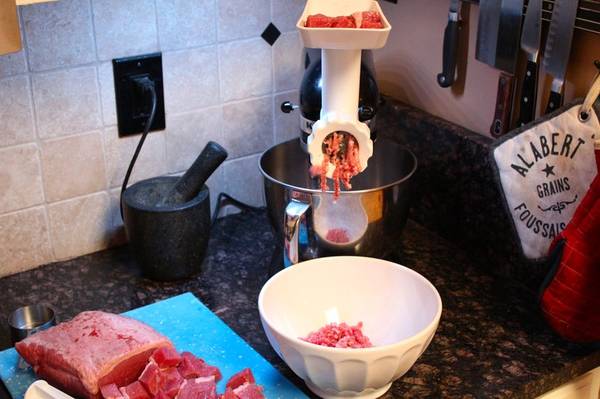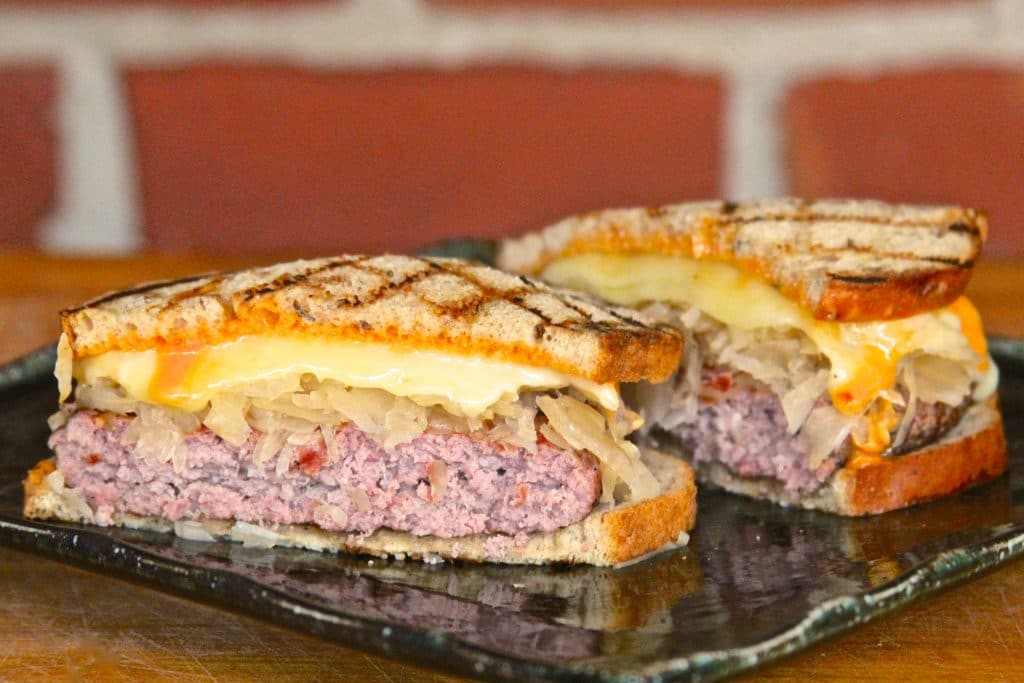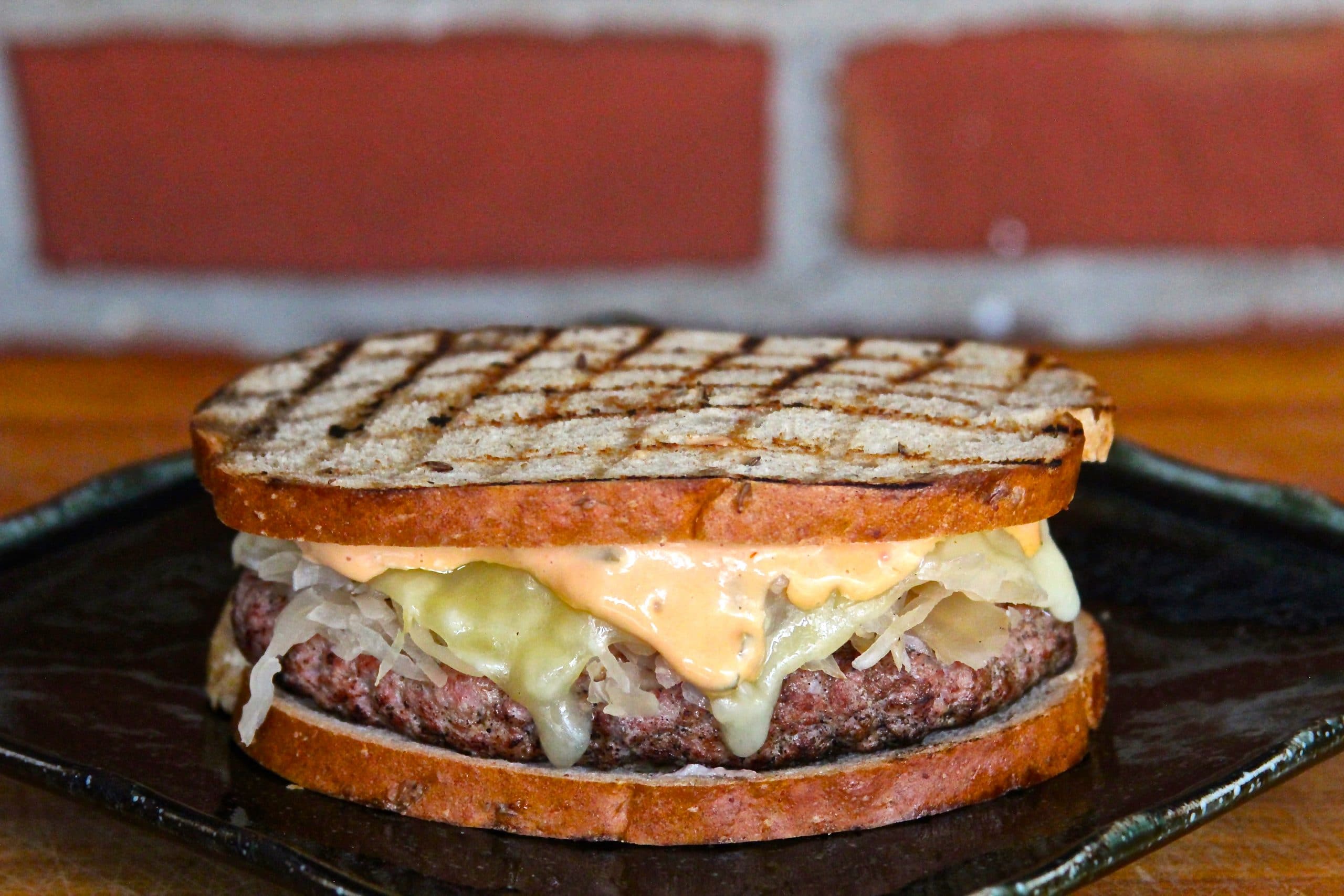This reuben sandwich and burger mash-up is sure to be your new favorite St. Patrick’s Day dish.
Some people golf, fish, or hunt to relax. I, on the other hand, enjoy hanging out at my local butcher shop, learning old school tips and techniques.
During one such recent visit, the idea for a mind bending burger popped into my head – the Grilled Reuben Burger, a.k.a. The St. Paddy Melt. At the time, I was learning how to grind and stuff sausages. It also happened to be a few days before St. Patrick’s Day, so house cured corned beef briskets were plentiful. As someone who is always thinking about creative grilling recipes, I naturally asked the butchers why no one grinds corned beef for burgers. Thoroughly stumped, they decided to give it a shot. After grinding the meat, I fried a test patty in a pan and the feedback was overwhelmingly positive. Ground beef with even more flavor from the curing process: what’s not to love?
Note that I like my Reubens to be packed with meat, just like at New York’s best delis so each patty in this recipe is 1/2-pound (226.8 g) of meat. If you prefer something smaller, simply divide the meat into six 6-ounce (170.1-g) portions and adjust the amount of bread and cheese accordingly!
After mastering the corned beef patty, my next challenge was to round out the burger with flavorful toppings. My attention immediately turned to the greatest corned beef sandwich in the world, the Reuben. For an entertaining history of the famed Reuben sandwich, check out Meathead’s “Rockin’ Reuben Sandwiches” article.
After gathering the necessary ingredients, I began assembling the burger. Since rye bread plays such an integral role in the Reuben, I opted to skip the bun and model the sandwich after a patty melt (a.k.a. St. Paddy Melt?). I placed the patty on a slice of toasted rye, then topped it with sauerkraut, Swiss cheese, and a drizzle of Russian dressing. With the second slice of toasted rye on top, I handed the sandwiches to the eager butcher shop staff. It was sheer Reuben burger bliss!
To make our latest burger of the month recipe at home, you’ll need a meat grinder. There are numerous hand cranked and electric grinders available to consumers, including my personal favorite, the food grinding attachment for KitchenAid stand mixers. Alternatively, you can grind the meat with a food processor using the method described in our article “Grinding Your Own Hamburgers.” Or you could try sweet-talking your own butcher into grinding the meat for you.
This recipe calls for prepared corned beef to keep things simple. If you want to go all out, make your own using AmazingRibs.com’s recipe for homemade corned beef.
Makes:
Takes:
Ingredients
- 2 pounds uncooked corned beef brisket
- 8 slices Swiss cheese
- 14 ounce can sauerkraut, drained
- 1/4 cup Russian dressing
- 8 slices rye bread, toasted
These recipes were created in US Customary measurements and the conversion to metric is being done by calculations. They should be accurate, but it is possible there could be an error. If you find one, please let us know in the comments at the bottom of the page
Method
- Prep. Place the grinder’s coarse 14 hole metal die and auger in the freezer to chill.
- Remove the corned beef from the packaging, rinse, and pat dry. Cut the entire prepared corned beef including any exterior fat into 1-inch (2.5 cm) cubes. Add the meat to the freezer for approximately 20 minutes until firm but not frozen.
- Remove the die, auger and meat from the freezer. Assemble the KitchenAid stand mixer’s grinding attachment according to the manufacturer’s instructions. Set a bowl in front of the grinder to catch the ground meat as it comes out. Turn the mixer on, setting it to speed 4. Begin feeding the cubed meat into the grinder, gently pushing it down with the stomper.

- Divide the ground corned beef into four even portions. Gently form the meat into patties that are approximately 1/2-inch (1.3 cm) wider than the bread slices to allow for shrinkage during the cooking process.
- Fire up. Prepare a grill for indirect cooking by placing a chimney full of pre-heated charcoal briquets on one side of the grill’s charcoal grate in order to create direct and indirect cooking zones. Adjust the grill vents to bring the temperature to about 225°F (107.2°C) on the indirect side. Add 2 to 3 chunks of your favorite smoking wood to the charcoal for flavor. On a gas grill, adjust the temperature knobs so that one half of the grill is off and the other half is heated enough to maintain a temperature of approximately 225°F (107.2°C) on the indirect side.
- Cook. Place the burgers on the indirect side of the grill. Cover the grill, positioning the vent directly above the burgers in order to force the smoke over and around the meat. Cook the patties for about 10 minutes.
- Push the tip of a rapid-read thermometer such as the Thermapen into the side of both burgers. When the temperature reaches 105°F (40.6°C), flip the burgers and cook for approximately 10 more minutes. Because they are not over direct heat, you do not need to flip them often.
- When the burgers reach an internal temperature of approximately 140°F (60°C), get ready to move them to the direct-heat zone. If you are on a gas grill, crank it up to high. On a charcoal grill, you may want to add more pre-lit coals. If necessary, take the meat off of the grill and close the lid while the hot side heats up. If you have a pellet cooker or another grill that doesn’t have enough radiant heat to sear, put a cast iron pan or griddle in there—when the griddle collects a lot of heat, it can do the job.
- Put the burgers on the direct heat side to brown them. Leave the lid up so the heat is concentrated on one side of each burger. If the fire flares up, move the burger to another spot—flare-ups can deposit bad-tasting soot. Flip the meat every minute, acting like a human rotisserie, so all the energy is focused on one surface at a time. The interior will warm, but not too much. Remove the burgers when browned and the interior reaches 160°F (71.1°C). Don't overcook them while waiting for the second side to be perfect. If one side is paler than the other, that’s acceptable. Top each patty with sauerkraut followed by two slices of Swiss cheese. Cover the grill and allow the cheese to melt, approximately 2 to 3 minutes.
- Serve. Set each patty on a slice of toasted rye bread. Brush one side of the remaining bread slices with Russian dressing. Crown each burger with a slice of bread, dressing side down. Serve immediately.




High quality websites are expensive to run. If you help us, we’ll pay you back bigtime with an ad-free experience and a lot of freebies!
Millions come to AmazingRibs.com every month for high quality tested recipes, tips on technique, science, mythbusting, product reviews, and inspiration. But it is expensive to run a website with more than 2,000 pages and we don’t have a big corporate partner to subsidize us.
Our most important source of sustenance is people who join our Pitmaster Club. But please don’t think of it as a donation. Members get MANY great benefits. We block all third-party ads, we give members free ebooks, magazines, interviews, webinars, more recipes, a monthly sweepstakes with prizes worth up to $2,000, discounts on products, and best of all a community of like-minded cooks free of flame wars. Click below to see all the benefits, take a free 30 day trial, and help keep this site alive.
Post comments and questions below
1) Please try the search box at the top of every page before you ask for help.
2) Try to post your question to the appropriate page.
3) Tell us everything we need to know to help such as the type of cooker and thermometer. Dial thermometers are often off by as much as 50°F so if you are not using a good digital thermometer we probably can’t help you with time and temp questions. Please read this article about thermometers.
4) If you are a member of the Pitmaster Club, your comments login is probably different.
5) Posts with links in them may not appear immediately.
Moderators